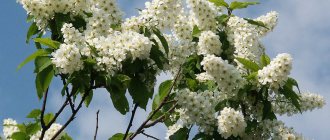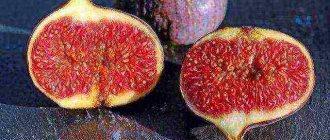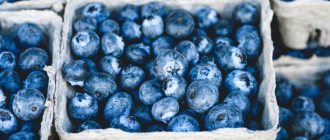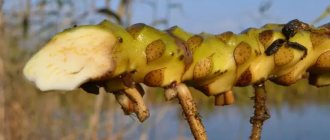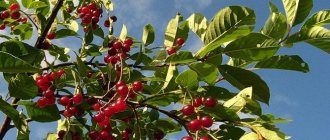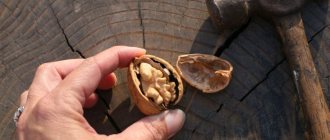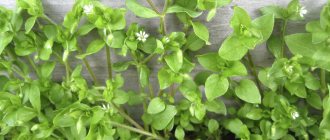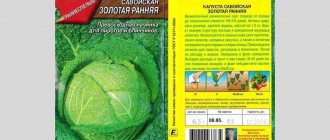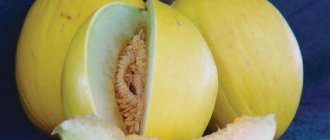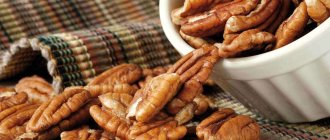History of selection
The homeland of Virginia bird cherry is North America, the state of Virginia, where its name comes from. In the wild, the crop grows in the forest-steppe zone along the banks of rivers on soft, fertile soils. Loves sunny, spacious places.
In Russia, this decorative shrub variety is popular in the southern regions and central zone, and is less common in the Far East and Siberia.
Mention of Virginia bird cherry as a crop growing in the Crimea and Central Asia dates back to 1724. It was officially recognized as an ornamental shrub in 1937, when the first garden specimens were grown from 4 seeds of wild Virginia varieties in the State Botanical Garden (GBS). Already in 1950, a red-leaved variety of Schubert bird cherry with delicate pink flowers and dark, purple leaves was cultivated.
In the photo you can see what the Virginia bird cherry variety Schubert looks like during the period of active flowering.
Description of Virginia bird cherry
Virgin bird cherry (red, red-leaved, lat. Prunus virginiana) is an ornamental multi-stemmed bush or tree, up to 5 - 7 m high with a wide, spreading crown. Classified as a garden ornamental plant of the genus Plum.
The bark of young plants is dark brown, while that of adults is grayish, sometimes with dark purple streaks. The buds are cone-shaped, 3–5 mm long, yellowish to dark brown in color.
The leaves are dense, glossy, jagged along the edges. The outer side is a rich green color, the inner side is slightly lighter. By autumn the foliage turns burgundy.
Pure white flowers of 15–30 pieces are collected in tassels-inflorescences up to 15 cm long. The flowering period begins in May–June and lasts on average up to 2 weeks. Virginia bird cherry flowers are odorless.
The fruits are large, reach 1 cm in diameter, and have a slightly astringent, sour taste. The color varies from dark red to burgundy-black, which is why Virginia bird cherry varieties are often called red. The berry ripening period occurs at the end of summer. Ripe fruits do not fall off the branches in winter, drying out slightly, but maintaining color and shape until next spring.
Breeders have developed several subspecies of the plant, differing in the type of crown, the shade of leaves and flowers, and the presence of fruits. The most common varieties of Virginia bird cherry:
- Schubert;
- Canada red.
Important! The fruits of any variety of Virginia bird cherry are edible and are used in cooking and therapeutic nutrition. The exception is unripe or spoiled berries - they are toxic.
Description of Virginia bird cherry Schubert
The Virginia bird cherry variety Schubert (Prunus virginiana "Shubert") is characterized by a wide crown, purple leaf color and resistance to pests. Excellent for decorating alleys, edges, and bush groups.
The plant is unpretentious, shade-tolerant, and tolerates pruning, decorative pruning, and replanting well.
Description of the Schubert bird cherry variety:
- tree height – up to 10 m, on average 5 – 6 m;
- crown diameter – up to 5 m; shape – pyramidal;
- the bark is dark brown in color, dissected with small cracks;
- young leaves are green, by mid-summer they become red-burgundy, purple; the leaf plate is dense, glossy;
- flowers are pale pink, bloom in the first ten days of May;
- bird cherry fruits of the Schubert variety are spherical, first red, then dark burgundy, closer to black, shade, fleshy; ripen towards the end of summer;
- the variety grows well in the shade or in diffused light, but prefers free, sunny space;
- Bird cherry is unpretentious to the ground; The greatest decorative effect is achieved when planted in moist, nutritious soil.
In the photo you can see the fruits of the Schubert bird cherry, collected in a brush.
Bird cherry Canada red (Canada red)
Virgin bird cherry variety Canada red is one of the most sought-after and popular ornamental multi-stemmed shrubs. Its height does not exceed 5 m, which allows planting even in small summer cottages.
The young spring crown is green, but by the beginning of summer it acquires a purple hue.
The period of active flowering occurs at the end of spring. Snow-white small flowers, practically odorless, are collected in tassels. The fruits are glossy, dark burgundy in color.
In terms of its characteristics, appearance, and description, Canada red bird cherry is similar to the Schubert variety. Photos of trees and fruits are almost identical:
- Variety Schubert.
- Canada ed.
The peculiarity of the Canada red variety is its increased frost resistance, which allows it to be cultivated in northern latitudes, the Far East, and steppe regions with low winter temperatures.
The variety can grow in shaded areas with any type of soil, but sun and well-moistened, fertile soil are preferable.
What plants does it go with?
The dimensions of Virginia bird cherry and its varieties bred by breeders make the tree ideal for “solo” plantings. The crop tolerates pruning well, so it can be used to form either a standard tree or a neat shrub with a crown of the desired configuration.
A bright green well-groomed lawn will be an excellent backdrop for the snow-white flowers of Virginia bird cherry
If you plant a flower bed at the base of a tree trunk, you need to take into account that Virginia bird cherry has a spreading, fairly dense crown. Therefore, unpretentious, shade-tolerant or shade-loving plants (both decorative foliage and decorative flowering) are suitable for it:
- periwinkle;
- host;
- viola (“pansy”);
- forget-me-not;
- fragrant violet;
- fescue
- sweet pea.
It is worth choosing “companions” for the Virginia bird cherry from plants that bloom at different times with it. And it is better not to plant other ornamental foliage plants next to hybrids in order to avoid unnecessary diversity and “overloading” of the composition.
When creating a flower bed at the base of the trunk, it is necessary to take into account that virginian bird cherry very actively forms basal shoots. You will have to constantly fight these layers.
Important! The culture is quite suitable for forming a hedge. It looks very impressive if you alternately plant “classic” trees and red-leafed virginian bird cherry.
Main characteristics
Red-leaved Virginia bird cherry, regardless of the variety, is a fast-growing, frost-resistant, unpretentious shrub with lush, beautiful flowering and tart, fleshy berries.
Drought resistance, frost resistance
Varieties of red Virginia bird cherry have high rates of drought and frost resistance, largely due to the fact that they are not susceptible to infections and diseases. They maintain the integrity of the leaf and bark well.
Bird cherry is most vulnerable to drought during the period of active flowering. During fruiting, the heat resistance of the variety increases.
When the air temperature reaches +30 - 35 oC and insufficient moisture, the plant begins to gradually shed its leaves, and burns appear on them - whitish, brown or black spots.
The least favorable conditions for the variety are observed during the dry period from July to early August. During this period, gardeners are advised to pay increased attention to sufficient soil moisture.
Virgin varieties are characterized by increased frost resistance. Bird cherry tolerates frosts down to –35 oC.
Important! Bird cherry of Virginia varieties is drought-resistant, but for abundant flowering, good fruiting and maintaining a thick crown in dry times, it requires timely, sufficient watering.
Productivity and fruiting
With proper care and favorable weather conditions, experienced gardeners remove up to 6–8 kg of fruit from one developed bush of Virginia bird cherry. On average, the variety produces about 2–4 kg of berries per season.
Good fruiting rates are due to late flowering - at the end of spring, when the likelihood of return spring frosts is minimal. The late ripening of the variety's berries at the end of summer gives them, compared to bird cherry, a sweeter, softer taste with moderate astringency and sourness.
Virgin varieties are characterized by active growth - up to half a meter per year. A young plant begins to bear fruit annually in the 4th year, if it was formed from a root shoot. A bush formed from green cuttings bears fruit in the 3rd year. On a plant grown from seeds, berries will appear no earlier than 5 years after planting.
The fruits of Virginia bird cherry are dense, elastic, and tolerate transportation well. If the harvest is not removed from the tree on time, the berries will dry out slightly, but will not fall off and will remain on the branches until the next flowering.
Area of application of fruits
Red bird cherry is rich in vitamin C, due to which it is widely used in therapeutic and preventive nutrition, as well as in cooking.
The fruits are frozen, dried, ground, canned, and consumed fresh. Bird cherry is good for making fruit drinks, compotes, jelly, decoctions and tinctures, and as a filling for baked goods.
In home medicine, berries speed up metabolism, normalize digestion, reduce sugar levels, and help fight colds.
Resistance to diseases and pests
High resistance to diseases and pests has made Virginia bird cherry varieties one of the most popular not only among amateur gardeners, but also among landscape designers. Red bird cherry is planted everywhere in urban park areas, squares, and alleys.
Advantages and disadvantages of the variety
Gardeners who have planted Virginia bird cherry on their plots note certain advantages and disadvantages of its cultivation.
In addition to the high drought and frost resistance of the variety, other advantages can be noted:
- ease of care;
- undemanding to soil composition;
- beautiful dense crown, lush flowering;
- ease of reproduction;
- pest resistance;
- fast growth.
In addition, the variety easily tolerates pruning and allows you to form any type of crown.
Important! Virginia bird cherry flowers have virtually no odor and are harmless to allergy sufferers.
The variety also has disadvantages:
- due to its rapid growth, the plant requires frequent pruning and uprooting of root shoots;
- carrion produces lush shoots in the spring, which also requires some thinning.
There are undoubtedly more advantages. Virgin bird cherry is an excellent choice for landscaping and beautifying the local area.
Benefits of red bird cherry
Red bird cherry is a unique plant widely used in folk medicine. Moreover, folk healers and herbalists use not only the fruits, but also the bark, leaves and flowers of bird cherry. Here are a few pros for those who are thinking about planting a tree on their property:
- red bird cherry helps eliminate diarrhea due to indigestion, poisoning, and intestinal infections;
- the tree bark has a pronounced diuretic and diaphoretic effect, which allows it to be used as a means to normalize body temperature during fever and to eliminate edema;
- fruits strengthen the walls of blood vessels, improve heart function, protect against the development of cardiovascular diseases;
- the bactericidal and anti-inflammatory properties of the berries and leaves make it possible to use decoctions of them to treat inflammation of the gums and oral mucosa, and throat diseases;
- The ability to liquefy and remove mucus from the lungs makes red bird cherry berries and decoctions from them an effective cough medicine.
Red bird cherry for men
Speaking about the benefits of red berries for men, it is worth noting the ability of the fruit to increase male strength. The improvement in blood circulation that occurs with regular use of the product has a positive effect on potency. The berry increases libido and can be used as an aphrodisiac.
Planting and caring for Virginia bird cherry
Virginia bird cherry seedlings are planted in sunny areas in spring or autumn at a distance of 5 m from each other.
The varieties are undemanding to the composition of the soil. Ideal conditions for growth are created on loamy soils with a neutral, slightly acidic or slightly alkaline environment. It is desirable for groundwater to lie no deeper than 1.5 m from the surface.
Landing algorithm:
- In the area chosen for planting, dig a hole 40–50 cm deep.
- Add drainage to the bottom: a layer of sand and peat.
- Pour in 300 g of superphosphate, cover with a layer of dug up soil so as not to burn the roots of the plant.
- Moisten the soil.
- Place the seedling in the hole and carefully straighten the roots.
- Cover tightly with soil and moisten.
- Mulch the tree trunk circle. Straw or sawdust is ideal for this.
At the final stage, the tops of the seedlings can be trimmed at a height of about 50–70 cm to form the skeletal frame of the future tree. But this procedure is not mandatory; it is carried out at the request of the gardener.
Aftercare
Regular care of Virginia bird cherry includes one-time watering in extreme heat, crown formation, removal of young shoots, and fertilizing.
An adult, strong tree does not need frequent watering. The developed root system ensures uninterrupted nutrition even in dry times. Generous soil moisture may be required when fruits ripen at high average daily temperatures and complete absence of precipitation.
Caring for the root hole of young bird cherry consists of regular weed removal, mulching, and loosening.
A grown tree is less demanding. The gardener's only task is to dig up young shoots sprouting from the roots of the mother tree or from fallen seeds.
For abundant flowering, fertilize the bird cherry tree: in the fall - manure or wood ash, in the spring - liquid mineral supplements.
Important! When applying mineral fertilizers, you must strictly adhere to the dosage indicated on the package so as not to damage the root system of the plant.
Virginia bird cherry does not require special preparation for the winter period. The high frost resistance of the variety allows the tree not to be covered.
How to care?
For a young specimen you need:
- Regular weeding;
- Loosening the soil around the trunk;
- Sanitary and formative pruning.
Since the tree can grow strongly, the crown branches in all directions and falls apart. You can prevent too active growth by trimming the crown.
Formation is possible in two ways: in the form of a tree in a standard form or in free form . The first method is preferred. Every year it is advisable to prune the main shoot of the tree by 50 centimeters. This is necessary for the formation of a lush crown of the tree.
Due to its high growth, the tree crown often thickens, so thinning it is advisable. The cut areas can simply be covered with whitewash. You can also use garden varnish.
The soil should be constantly moist, but Virginia bird cherry does not need as much watering as some other bird cherry varieties. Also, the soil must be constantly loosened to maintain soil moisture at normal levels. It is not for nothing that the variety often grows along the banks of rivers.
Fallen bird cherry leaves have a beneficial effect on the composition of the soil.
You should not cover the crop for the winter, as it is frost-resistant.
Virginia bird cherry has fruits of red juicy color. They remain on the branches of the tree and gradually begin to dry out. The fruits decorate the tree until the end of spring next year.
The fruits have been actively used in cooking since ancient times. They are used to make filling for pies, and also prepare flour, which is used for baking. In addition, various drinks are prepared from the berries - compote, jelly, tea and wine. Wine is a separate matter. It turns out incredibly tasty and beautiful, since the berries are not acidic, but they are very bright and rich.
Virgin cherry fruits
These fruits are ideal for freezing. In winter, they can also be used to make jelly and compotes or add to tea.
However, red bird cherry fruits can only be consumed when they are ripe, since green berries contain toxic substances.
Pruning virgin bird cherry
The first pruning of a Virginia bird cherry seedling is carried out immediately after planting, if the tree has reached a height of 60 - 80 cm. It is shortened to about half a meter in order to establish strong lower branches. Further pruning is carried out annually; it can be decorative (to form the crown) or sanitary.
Formative pruning is carried out in early spring once a year, before sap flow begins. To create a decorative look, the tree trunk is shortened by 50 cm, forming skeletal branches. The shoots that grow inward and also thicken the crown are removed.
Sanitary pruning is carried out not only in the spring, but throughout the year: damaged, rotten, pest-infested shoots are cut off, and the cut is treated with garden varnish or regular whitewash.
Benefits of red bird cherry leaves, flowers and bark
Not only the fruits, but also all other parts of the plant have beneficial properties:
- red bird cherry bark contains tannins, which have an astringent effect, relieve inflammation, phytoncides in its composition are effective in the treatment of heart and vascular diseases, bronchopulmonary diseases;
- bird cherry leaves contain substances that can cure gout and eliminate anemia;
- flowers are a powerful source of phytoncides; during flowering, bird cherry disinfects the air around it, repels pests, kills viruses and bacteria.
Methods of propagation of Virginia bird cherry
Gardeners do not have any difficulties with the propagation of Virginia bird cherry. A young tree can be obtained from a seed, root shoots, or green cuttings.
Propagation by seeds is an ineffective method that requires a lot of time. Such bird cherry will bloom no earlier than 5 - 7 years after planting. In addition, some varietal characteristics of the mother tree may be lost.
A more reliable and popular method of propagation is by green cuttings. For seedlings, cut strong young shoots that have finished growing, remove the leaves, leaving only the top 2. After soaking the cuttings (any growth stimulant is used for this), they are transferred to nutrient soil and watered well. In autumn, the shoots are planted in a permanent place.
Bird cherry grafting gives good results. The variety begins to bear fruit already in the 3rd year, retaining all the specific features and characteristics.
Red bird cherry in cooking
Red bird cherry is used more actively in cooking than black bird cherry . Its taste is sweeter and does not have a pronounced astringency, and the size of the fruit is larger. The berries are used to make jam, compotes, and jelly.
They are dried and then used in various dishes or eaten as raisins. Dried fruits can be ground in a coffee grinder or food processor and used as flour. It is added to baked goods and used to thicken sauces. Bird cherry flour is very flavorful and gluten-free, making it a valuable product for people suffering from gluten intolerance.
To prepare jam, jam, jelly and other dishes and drinks, the seeds should be removed from the bird cherry. To do this quickly, you should use a metal sieve. The fruits are washed and then ground through a sieve. The second way is to blanch the berries by boiling them for about 3 minutes in boiling water and then grind them through a sieve. After boiling the berries in water, the pulp is easier to separate from the seeds, but this method is not suitable for all dishes.
Diseases and pests
Most often, the variety is susceptible to infection by bird cherry moth, marsupial fungus, and suffers from Fusarium drying out. Less commonly, aphids, weevils, and silkworms may invade. Treating the plant with insecticides in early spring - before flowering and in early summer - after, as well as timely pruning, helps to avoid extensive damage to the bark and leaves.
Advanced cases require immediate measures: damaged shoots are completely removed, the tree is treated with chemicals.
Traditional methods also help to repel insects: spraying with a soap solution or tobacco infusion. But they relate more to preventive measures.
